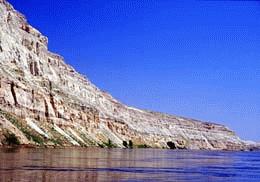On November 2, 1981, the Seattle district of the Army Corps of Engineers announces that it is abandoning plans for the proposed Ben Franklin Dam near Pasco, citing overwhelming public opposition to a project that would have flooded the last free-flowing stretch of the Columbia River.
The Corps of Engineers identified Pasco as a potential dam site in a master plan adopted in 1932, but the project was given low priority. Not until the 1960s, with the completion of the John Day Dam in southwestern Washington, did the Corps begin preliminary studies for construction of what was to be called the Ben Franklin Dam.
The dam would have generated 3.8 billion kilowatt hours of electricity annually -- equal to eight million barrels of oil -- and it would have opened the upper Columbia to navigation, turning Wenatchee into a port city. But it also would have flooded the Hanford Reach, by then the last undammed segment of the river, flowing 51 miles from the Priest Rapids Dam to the Tri-Cities. The dam's reservoir would have destroyed the few remaining places on the river where chinook salmon, steelhead trout, and other fish can spawn naturally. It also would have inundated 11,500 acres of wildlife habitat. Additionally, it would have raised the water level at the Hanford Nuclear Reservation, requiring the decommissioning of several nuclear reactors and increasing the risks of contamination from underground tanks used to store radioactive wastes on the site.
An unusual coalition of environmentalists, tribal officials, sports and commercial fishermen, and representatives of the Atomic Energy Commission (operator of the Hanford nuclear site) united in opposition to the dam. The Corps shelved the engineering studies in 1970, although a spokesman noted that "The goal of optimum development is far from reached" (Bullard, 95).
In 1978, the Corps resurrected the project, budgeting $1 million to complete the engineering studies. The opposition was even broader and more vociferous than it had been a decade earlier. "All the reasons for not building Ben Franklin in 1970 remain today," wrote one newspaper columnist. "The area still is the last stronghold of spawning steelhead and chinook salmon. Canada Geese still nest here and use by other wildlife has not ceased. The archaeological sites have not disappeared. The understanding of ground water is somewhat better now than in 1970 but the close proximity of a reservoir and stored nuclear wastes in tanks that have been known to leak isn't my idea of good planning" (Journal-American, 1980).
The proposal drew support only from a few public utility districts, the ports of Chelan and Douglas counties, and businessmen who hoped to profit from barge transportation to Wenatchee. The Corps subsequently announced it was withdrawing all plans for the Ben Franklin site, saying "the strength of opposition suggests that further study is pointless until state, regional and federal authorities accept the environmental tradeoffs necessary for development" (The Seattle Times).

